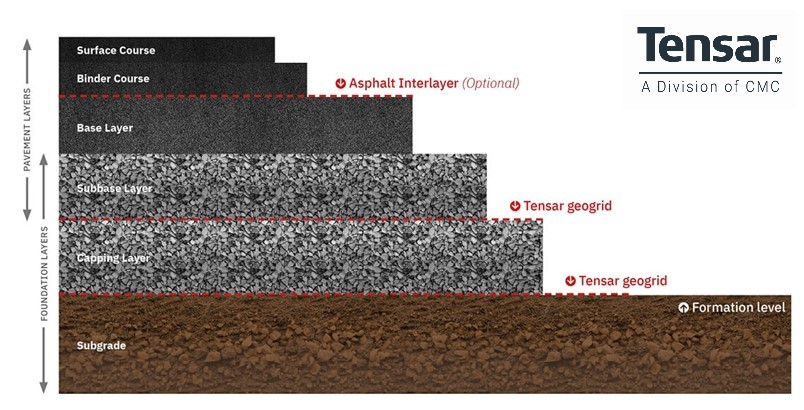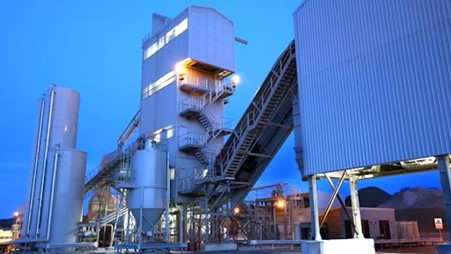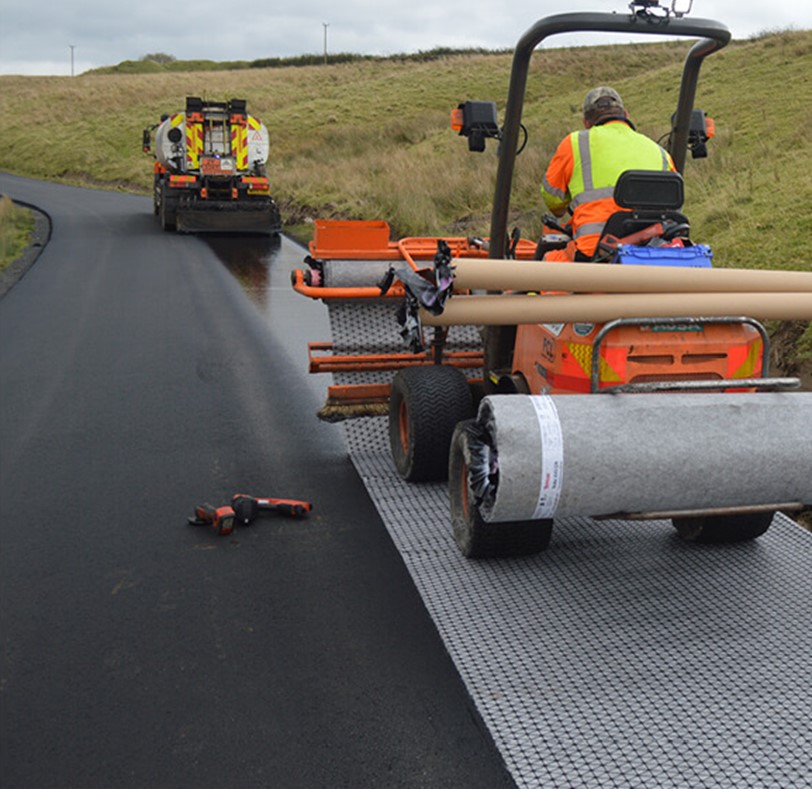Asphalt Pavement Design: Overview and Guidance
by Piotr Mazurowski, on July 04, 2024
Asphalt pavement design is widely used in road construction. Comprising a mix of aggregates and bitumen, asphalt has replaced tarmac over time as the material of choice for roads in the UK (with the latter now more commonly found in domestic driveways).
But what makes asphalt so ideal for pavement design? First and foremost, it’s a more economical option than concrete and other common road surfacing materials due to the wide availability of petroleum-derived bitumen used in the production of asphalt. It also helps to create long-lasting roads by virtue of its high strength and durability, particularly when paired with suitable asphalt reinforcement products.

Figure 1 - Pavement layers that make up an asphalt pavement design in UK
Written by specialist author, Piotr Mazurowski, this guide provides an overview of asphalt pavement design. Read on to discover more about the diverse types of asphalt, the various mix designs that are in use, and the asphalt layers that comprise the overall pavement structure. This post also recommends how to improve pavement life – and introduces some trends in the use of asphalt reinforcement products that could shape how asphalt pavements are designed for enhanced performance and resilience in the future.
Looking for something specific? Use the links below to navigate to each section.
- What is asphalt pavement design?
- Types of asphalt and their uses?
- Asphalt mix design methods?
- Is an asphalt pavement rigid or flexible?
- What are the differences between an asphalt pavements and concrete pavement?
- Asphalt pavement design methods?
- Future trends in asphalt pavement design?
What is asphalt pavement design?
Asphalt pavements are designed with one or more layers of asphalt, which are applied direectly onto the subgrade or an aggregate base. The pavement design process determines the required thickness of each layer, considering the required pavement design life, foundation strength, climate, and the properties of the asphalt mix, base, and subbase materials.
A design can be optimised for minimum construction cost, while meeting the design life requirements. This process may involve an assessment of the cost implications of varying layer thicknesses and/or incorporating geogrid stabilisation products to enhance unbound layer performance.
There are different approaches that may be followed for asphalt pavement design. Standard designs, often using design charts that allow for different foundation strengths and base material types, or various analytical design methods. We will look at these in greater depth below.
Types of asphalt and their use
Mix design of asphalt is important. Varying the proportion, grade, and type of bitumen binder has a significant impact on durability, strength, and workability of the mix. The addition of Portland cement filler, polymers, rubber granules or other additives can enhance long term performance. Asphalt reinforcement products can be incorporated within asphalt layers to improve fatigue performance and extend life. The particle size, shape, and grading of the aggregate component plays a key part in the mechanical properties of the mix. Here are some of the common types of asphalt.
Asphalt concrete (AC)
This is the most commonly used mix for road pavements. It has a high compressive strength and rutting resistance that results from the smooth particle size distribution of the aggregate used. The graded aggregate locks together providing stability to the mix.
Enrobé á Module Élevé (EME)
Developed in France is a high modulus asphalt material. EME2 (2nd generation EME) is now commonly used as a binder course for high volume roads in the UK. The binder course is located in the high shear zone between surface course and base course. EMA2 has a high bitumen content and a finer aggregate grading than is typical for base course in the UK. It has low permeability, good resistance to road cracking and rutting, and has good load spreading capability.
Hot Rolled Asphalt (HRA)
This is familiar to the UK but not commonly used elsewhere. In this material the particle size distribution has a gap, with a finer particle size fraction and separated coarse particle sizes fraction. A high viscosity binder provides stability, binding the larger particles together. Coated stone chippings are rolled into the surface to improve friction and durability.
Warm Mix Asphalt (WMA).
All of the above materials are hot mixed. Warm mixed asphalt is similar to the traditional hot mix asphalt (HMA) and has similar characteristics. But is has an advantage in that the mix can be prepared, placed, and compacted at a lower temperature. There is growing interest in this type of mix for environmental reasons because of clear savings in terms of energy and carbon emissions.
Stone Mastic Asphalt (SMA)
Stone Mastic Asphalt is sometimes called stone matrix asphalt. Developed in Germany and often used as a surface layer, this material is attractive due to its high deformation resistance and low tyre noise. It uses a gap-graded aggregate with a high proportion of coarse aggregate and fine particle size fraction. Its strength predominately comes from the direct stone-to-stone contact of the larger stone particles forming a structural skeleton. It is very dense mix with a high mastic binder content comprising, modified bitumen, filler, and fibre. SMA has become increasingly frequent used also as a binder and asphaltic base course layer.
Porous Asphalt (PA)
Porous Asphalt has an open graded aggregate mix with no fine aggregate particles. This leaves a high proportion of interconnected voids within the mix that allows water to pass through. Porous asphalt pavements allow surface water to drain and reduce spray from tyres. They can be a component of SUDS systems (Sustainable Urban Drainage Systems).

Figure 2 - Asphalt batching plant (source www.forconstructionpros.com)
Asphalt mix design methods
Separate from asphalt pavement design, which determines the pavement structure, asphalt mix design is concerned with defining the components and proportionality of the asphalt material - bitumen, aggregate, and any additives. A well-defined process is followed to arrive at a mix that will have the required properties, durability, and cost. It should be noted that asphalt mix design is not always done by pavement designers – usually it is the contractor who designs the mix based on client specifications, project requirements and the available materials (bitumen grade, stone type and grading etc) he is going to use.
Is an asphalt pavement rigid or flexible?
Pavement structures fall into two main categories, rigid pavements, and flexible pavements. The design methods available for each of these types are quite different.
Rigid pavements
These rely on the strength and stiffness of the structural pavement layer to distribute wheel loads widely across the subgrade. The structural layer will be concrete. This may be unreinforced with dowelled joints at regular spacing, or steel reinforced, with or without contraction joints.
Flexible pavements
Flexible pavements are made up of several layers with the stronger stiffer layers at the top. The pavement is designed to accommodate some degree of elastic deformation under load. Wheel loads are distributed down through each of the layers to the subgrade. Subgrade strength is therefore a key factor in design. Typically, the upper layers will be asphalt and the lower layers will be unbound aggregate or hydraulically bound granular materials. Pavements with hydraulically bound base material are often referred to as semi-rigid (see below).
Semi-rigid pavements
Semi-rigid pavements have asphalt surfacing similar to flexible pavement structures, but they have a stronger, stiffer base layer using a hydraulically bound mixture (HBM). A hydraulically bound mixtures comprises aggregate, water and a hydraulic binder that will set and harden to create a strong stiff material. Portland cement is the most commonly used hydraulic binder, but other hydraulic binders include lime, fly-ash and granulated slag.
Asphalt pavements
These are flexible pavements with multiple layers. The pavement structure usually comprises one or more layers of unbound granular material supporting two or more layers of asphalt material. The upper layers being stiffer and stronger, and more expensive per mm thickness than the lower layers. Traffic load is transferred through successive layers down to the subgrade.

What are the differences between asphalt pavements and concrete pavements?
The obvious difference is seen at the road surface. The difference between concrete and asphalt road surfaces are clearly visible due to the materials being used. The concrete pavement will have a brushed finish at right angles to traffic flow to improve surface friction and may also have visible contraction joints at regular intervals. Asphalt pavements will vary from black when newly constructed to a grey colour after weathering. Concrete pavements tend to produce more tyre noise than asphalt pavements. However, the fundamental difference is that concrete pavement are rigid pavements, while asphalt pavements are flexible pavements.
The initial cost of concrete pavements is higher, but service life is longer, and concrete pavements may be expected to require less maintenance during their service life compared to asphalt. Asphalt pavements require periodic surface treatments or overlays to extend their service life. Asphalt reinforcement products like glass grid pavement reinforcement may be incorporated to control cracking and further increase the life of overlays. Concrete surfaces are less susceptible to temperature changes. Asphalt surfaces will soften in higher temperatures, and this can lead to surface rutting. However, temperature induced expansion and contraction of concrete slabs can lead to cracking unless controlled by reinforcement or correctly spaced joints. The joints in concrete pavements tend to be their weakness, with most problems of degradation starting at or near joints.

Figure 3 - Asphalt overlay - reinforced with Tensar AX5-GN interlayer
Asphalt pavement design methods
Asphalt pavement design is separate from asphalt mix design covered above. Asphalt pavement design is concerned with defining the pavement layers, by material type and thickness.
The process begins by defining the target service life of the road in terms of a minimum number of standard axles. The next major consideration is the subgrade. It is essential to understand the nature, strength, and moisture condition of the subgrade soil as this will be the first layer of the pavement foundation.
In the UK and Northern Ireland, the approach for asphalt pavement design is set out in Design Manual for Roads and Bridges CD 226 ‘Design for new pavement construction’. Two approaches are set out. The first, and most commonly followed approach uses ‘standard’ design types, and used charts that enable determination of layer thicknesses for different foundation conditions using ‘permitted materials’ defined in the document. The second approach enables the use of ‘alternative design procedures’ using analytical methods.
Design following CD 226 standard design types for flexible pavements
Step 1 - Determine design traffic
Step 2 - Define the foundation stiffness class. Each class (1-4) has a minimum assumed long-term confined foundation surface modulus (MPa). The foundation surface is considered to be the top of subbase. For a given subgrade condition, a higher surface modulus is achieved by increasing the thickness of subbase and capping layer beneath. Alternatively, a stabilisation geogrid such as Tensar InterAx, may be used to create a mechanically stabilised layer with a thinner subbase or capping layer that achieves the required foundation class at lower cost. The design of foundation is covered in CD225 “Design for new pavement foundations”.
Step 3 - Define the pavement materials for each layer. Flexible pavements can be either ‘flexible with an asphalt base’ or ‘flexible with an HBGM base’ ((hydraulically bound granular material). For both types of options for the surfacing layer will be either HRA or a type of AC. For the flexible with HBMG base type, the options for the binder course will be HRA, AC, EME2 or SMA. For the asphalt base type, options for the base material and binder course will be AC or EME2.
Step 4 - Use of the Fig 2.20 Nomograph from CD 226 to determine total thickness or the asphalt layers.
Analytical design
Analytical design involves multiple iterative steps to arrive at the optimised design. Computer based design tools are therefore required. Most of those available follow a Mechanistic-Empirical (M-E) approach.
Step 1 - Determine pavement life in terms of design traffic
Step 2 - Define pavement materials.
Step 3 - estimate the performance properties of each layer.
Step 4 - Carry out a structural analysis using a multi-layer elastic model of the pavement.
Step 5 - Compare critical stresses, strains, and deflections with the allowable values.
Step 6 – Repeat making layer thickness adjustments until required life is achieved.
There are various analytical tools available. Tensar has developed M-E whole pavement analysis tools and subgrade stabilisation design tools that can incorporate the benefits of stabilisation geogrids that enhance the performance of unbound layer resulting in an increase in design life, or reduced layer thickness.
Future trends in asphalt pavement design
There are several drivers for change regarding asphalt pavement design.
Net Zero target – Stakeholders are pushing for reduced carbon emissions from the construction sector. Road Authorities across the globe are aware that road construction and maintenance is a significant contributor to carbon emissions. Efforts are being made to reduce the energy consumption and emissions from road works. Initiatives in this area include the use of warm mix asphalt that can be produced and laid at lower temperatures. The use of innovative materials, such as biogenic asphalt, and recycled components.
Climate change resilience – Seeking solutions that will improve the resiliency of road pavements to effects of flooding, wide temperature fluctuations and changes in permafrost and freeze thaw-cycles.
Improved safety – Reducing construction times and reducing or eliminating pavement maintenance, lessens the likelihood of traffic incidents. Potholes are a major safety concern as well as having a high economic impact. Improving pavement performance can prevent potholes forming in new roads.
Cost reduction – This has always been a strong driver in the industry, but Road Authorities are operating with ever tighter budgets. The need for innovation in materials and methods has never been greater. In some cases, barriers to highway innovation have to be identified and overcome to enable innovation to flourish and make a difference.
Want to learn more about asphalt pavement design?
Tensar has additional content that you may find valuable.
• Flexible Pavement Layers and Design
• Road Construction: Pavement Types, Methods, and Design
• Road surface: types and materials
• What is an ESAL? Guide to equivalent single axle load
• What causes potholes?
• Tensar + design sofware



.jpg?width=400&height=400&ext=.jpg)